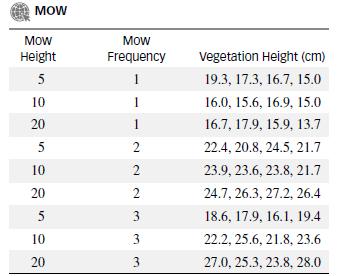Refer to the Landscape Ecology Journal (Jan. 2013) study of mowing effects on vegetation in highway rights-of-way,
Question:
Refer to the Landscape Ecology Journal (Jan. 2013) study of mowing effects on vegetation in highway rights-of-way, Exercise 14.35. Recall that a 3 × 3 factorial design was employed to estimate the effects of mowing frequency and mowing height on the mean height of vegetation. The researchers detected evidence of interaction between the two factors, mowing frequency (once, twice, or three times per year) and mowing height of the equipment (5, 10, or 20 centimeters). Consequently, they did not rank the mowing frequency means independent of mowing height, and vice versa. Rather, the researchers ranked all 3 × 3 = 9 treatment means in order to determine which treatments yield the lowest and highest mean vegetation height. Use a multiple comparisons method to carry out this analysis at an experiment wise error rate of .05.
Data from Exercise 14.35
A vegetation height of greater than 30 centimeters on a highway right of- way is generally considered a safety hazard to drivers. How often and at what height should the right-of-way be mowed in order to maintain a safe environment? This was the question of interest in an article published in the Landscape Ecology Journal (Jan. 2013). The researchers designed an experiment to estimate the effects of mowing frequency and mowing height on the mean height of vegetation in the highway right-of-way. Mowing frequency was set at three levels—once, twice, or three times per year. Mowing height of the equipment was also set at three levels—5, 10, or 20 centimeters. A sample of 36 plots of land along a highway right-of-way were selected, and each was randomly assigned to receive one of the 3 × 3 = 9 mowing frequency/mowing height treatments. The design was balanced so that each treatment was applied to 4 plots of land.

Step by Step Answer:

Statistics For Engineering And The Sciences
ISBN: 9781498728850
6th Edition
Authors: William M. Mendenhall, Terry L. Sincich





